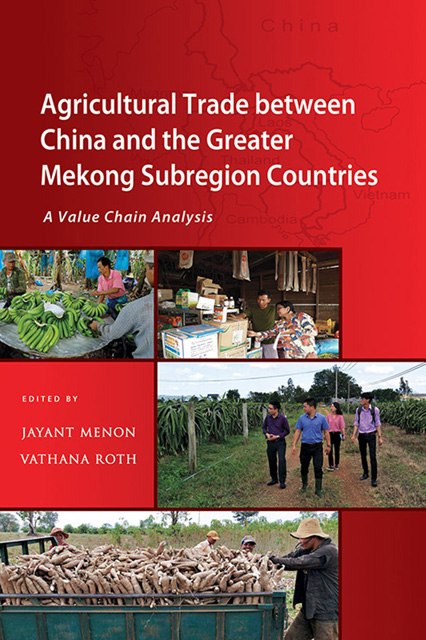Book contents
- Frontmatter
- Contents
- List of Tables
- List of Figures
- List of Annexes
- Foreword
- Preface
- Acknowledgements
- Abbreviations and Acronyms
- The Contributors
- 1 Agricultural Trade between China and the Greater Mekong Subregion Countries: An Overview
- 2 Economic Structural Change in China and the Implications for Agricultural Trade in the Lancang-Mekong Region
- 3 Agricultural Exports from Thailand to China: A Value Chain Analysis of Cassava and Durian
- 4 Agricultural Exports from Cambodia to China: A Value Chain Analysis of Cassava and Sugarcane
- 5 Agricultural Exports from Laos to China: A Value Chain Analysis of Rice and Cavendish Banana
- 6 Agricultural Exports from Myanmar to China: A Value Chain Analysis of Maize
- 7 Agricultural Exports from Vietnam to China: A Value Chain Analysis of Dragon Fruit and Coffee
- Index
4 - Agricultural Exports from Cambodia to China: A Value Chain Analysis of Cassava and Sugarcane
Published online by Cambridge University Press: 30 June 2023
- Frontmatter
- Contents
- List of Tables
- List of Figures
- List of Annexes
- Foreword
- Preface
- Acknowledgements
- Abbreviations and Acronyms
- The Contributors
- 1 Agricultural Trade between China and the Greater Mekong Subregion Countries: An Overview
- 2 Economic Structural Change in China and the Implications for Agricultural Trade in the Lancang-Mekong Region
- 3 Agricultural Exports from Thailand to China: A Value Chain Analysis of Cassava and Durian
- 4 Agricultural Exports from Cambodia to China: A Value Chain Analysis of Cassava and Sugarcane
- 5 Agricultural Exports from Laos to China: A Value Chain Analysis of Rice and Cavendish Banana
- 6 Agricultural Exports from Myanmar to China: A Value Chain Analysis of Maize
- 7 Agricultural Exports from Vietnam to China: A Value Chain Analysis of Dragon Fruit and Coffee
- Index
Summary
INTRODUCTION
Cambodia resumed trade with China in 1989, after opening its economy to the region and the world by lifting export bans, privatizing public enterprises and allowing foreign direct investment (FDI) inflows. Chinese firms started to invest in Cambodia’s textile and garment industry in 1993, after Cambodia held its first multiparty national elections in decades, aiming to tap into the country’s trade preferential status (i.e., most favoured nation and generalized system of preference) and low labour costs. Trade flows between the two countries have since been partially facilitated by a gradual reduction in the tariff rates on tradeable commodities under the China-ASEAN Free Trade Agreement (FTA) signed in 2014. It was expected that all things being equal, there would be greater potential for Cambodia to expand its exports to China. However, bilateral trade between the two countries at the time mainly involved exports of intermediate inputs for textile and garment manufacturing from China to Cambodia. Although the magnitude of total trade has been small, Cambodia has run up a substantial trade deficit with China. Cambodia’s imports from China grew exponentially to US$4,550.9 million in 2016, but export growth continued to lag at only US$609.3 million (IMF 2017). It is clear that Cambodia has not yet been able to seize the growing opportunities from the closer trade relationship. Given that China is the world’s second-largest agricultural market and Cambodia is a predominantly agrarian society with strong agricultural comparative advantages, the two countries should have the potential for economic and trade cooperation in agricultural commodities.
Due to the considerable efforts made over the last three decades to improve agricultural production, Cambodia’s agricultural exports have gained greater access to international markets. Cambodia’s membership of ASEAN in 1999 and its accession to the World Trade Organization in 2004 heralded a new era of land reform in favour of agriculture, which became a milestone in the country’s development. The government set out to incentivize corporate investments in industrial agriculture through the issuance of economic land concessions (ELCs). Foreign investors seized the opportunity to secure long-term leases on vast swathes of arable land for large-scale industrial monocropping.
- Type
- Chapter
- Information
- Agricultural Trade between China and the Greater Mekong Subregion CountriesA Value Chain Analysis, pp. 108 - 163Publisher: ISEAS–Yusof Ishak InstitutePrint publication year: 2022

